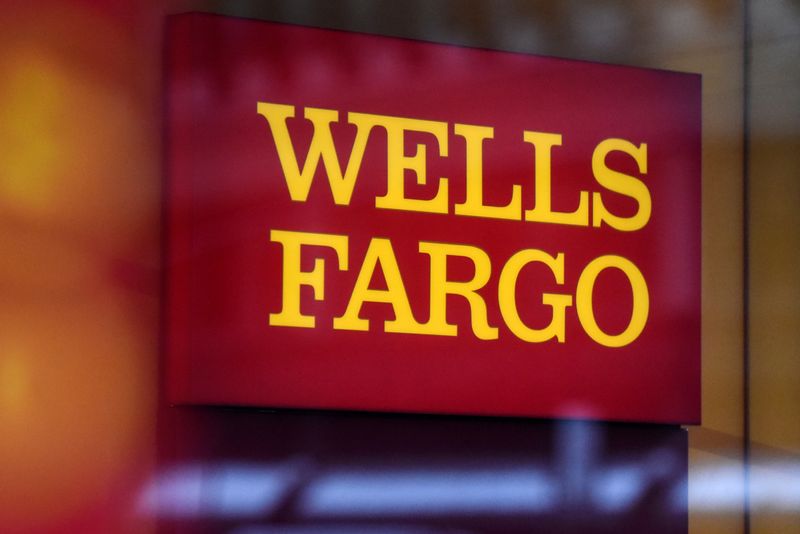Wells Fargo profit beats forecasts as provisions shrink; shares rise
By Noor Zainab Hussain, Manya Saini and Saeed Azhar
(Reuters) -Wells Fargo's profit beat analysts expectations in the third quarter as it set aside less money than expected to cover potential loan losses and predicted its interest income would stabilize, sending shares up 6% on Friday.
Executives at top lenders have said that U.S. consumer finances remain healthy, underpinned by a solid job market, while activity is rebounding in capital markets.
"The U.S. economy remains strong," CEO Charlie Scharf told analysts. Inflation is slowing and a resilient labor market is supporting consumer spending, Scharf said, strong company balance sheets are fueling consumption and investment.
In the near term, Wells Fargo forecast its net interest income (NII) -- or the difference between what it earns on loans and pays out for deposits -- would drop by 9% in 2024. That was more pessimistic than analyst expectations of an 8.4% decline, after the Federal Reserve cut borrowing costs last month.
Still, Wells Fargo's net interest income could actually benefit from rate cuts because it will pay out less to clients to hang on to their deposits, its Chief Financial Michael Santomassimo told reporters. NII could level out in the fourth quarter and form a trough, he said.
Rates are coming down on certificates of deposit, promotional savings instruments and on most interest-rate sensitive deposits in its commercial banking business, Santomassimo said.
"As we continue to see rate cuts, those trends will continue, and that'll be a net positive for NII as we look forward," he said, because the bank will need to pay less to depositors to hold onto their money.
The fourth-largest U.S. lender reported third-quarter earnings per share of $1.52, compared with expectations of $1.28, according to data from LSEG.
Wells Fargo's NII dropped 11% to $11.69 billion in the quarter.
Analysts on average had predicted $11.87 billion, according to estimates compiled by LSEG.
"We remain bullish on WFC shares," said Raymond James analyst David Long. "Fundamental performance was strong and likely leads to higher earnings per share estimates," he said, citing higher noninterest income and the bank's businesses beating their projections.
Banks' interest income, which had benefited in recent years as the Fed raised interest rates, is expected to keep declining for the rest of 2024.
The U.S. central bank last month lowered its benchmark policy rate for the first time since 2020, cutting it by 50 basis points. Policymakers have projected another half of a percentage point reduction by the end of this year.
The rate cut was followed by top banks lowering prime lending rates, which will likely shrink their interest income. Banks have also tightened lending standards this year.
Santomassimo said consumer activity and spending remained quite strong.
Wells Fargo's revenue declined 2% to $20.37 billion in the third quarter.
Its loans to borrowers fell to $910.3 billion versus $943.2 billion a year earlier.
Loan demand has been subdued as higher interest rates deterred commercial and consumer borrowers. At the same time, banks have had to compete for deposits by paying clients more.
Wells Fargo set aside $1.07 billion in provisions to cover souring loans. That compared with $1.20 billion a year earlier.
Office loans are still an area of concern that could lead to more losses, the CFO said.
Rival JPMorgan Chase (NYSE:JPM )'s profit dropped in the third quarter as a bigger provision for potential loan defaults offset gains from investment banking, it said on Friday.
Wells Fargo also repositioned its investment portfolio in the third quarter, taking a 10-cents-a-share loss on the sale of debt securities, which were reinvested in higher-yielding paper.
Wells Fargo is also reportedly doubling down on efforts to lift a $1.95 trillion asset cap imposed by the Federal Reserve that prevents the bank from growing until regulators deem it has fixed problems dating back to the 2016 fake accounts scandal.
In September, a U.S. banking regulator found its safeguards against money laundering and other illegal transactions were too lax and restricted its ability to expand in risky businesses.
The asset cap curtails Wells Fargo's ability to take in more deposits and expand its trading business, two potential growth areas for the bank, CEO Scharf said earlier this year.
It still has eight regulatory punishments, called consent orders, that it is working to address.
Source: Investing.com
